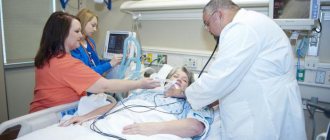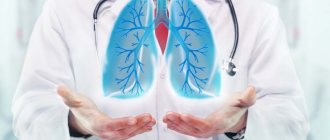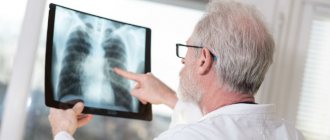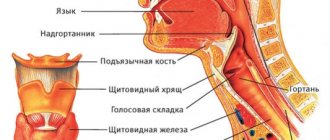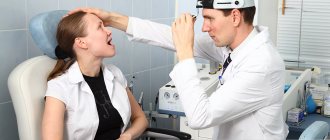Pulmonologist
Prokhina
Maria Egorovna
Experience 38 years
Pulmonologist
Make an appointment
Pulmonary sarcoidosis (benign granulomatosis) is a disease that affects various tissues of the body. But most often it manifests itself in the respiratory organs. With this disease, granulomas form in the lungs, as well as in the trachea, bronchi and lymph nodes.
The danger of sarcoidosis is that granulomas gradually grow, merge, then resolve and leave behind scar tissue. This greatly affects the functioning of organs - in particular the lungs - which cannot fully perform their functions. With superficial ventilation, the respiratory function is disrupted - and this, as is known, entails a load on all internal organs, because the blood cannot supply oxygen to different systems of the body.
The disease is not contagious (unlike tuberculosis) and does not pose any danger to others.
Symptoms
Symptoms of sarcoidosis include the following:
- Labored breathing. This is especially noticeable at first during physical activity - even quite moderate ones.
- Problems with appetite, sudden weight loss.
- Weakness in muscles, tendency to fatigue.
- Dry cough, expectoration of blood.
- Painful sensations in the chest.
- Redness of the skin as a result of a strong rush of blood.
All these symptoms of sarcoidosis should immediately alert the patient and force him to seek specialist help. Pulmonologists deal with this disease, but if you doubt the first signs of the disease, you can also contact a general practitioner, who will then refer you to the right doctor.
Symptoms of pulmonary sarcoidosis
The disease can occur without pronounced symptoms for a long time, up to large volumes of affected tissue.
Frequent symptoms are:
- increased fatigue,
- cough,
- slight increase in body temperature
- the appearance of red itchy spots on the skin of the legs (erythema nodosum)
Surprisingly, patients with sarcoidosis often come to the doctor not with the listed symptoms, but with complaints of discomfort in the eyes (conjunctivitis, dryness), skin lesions (brown, yellow plaques appear), based on these and other indirect signs, an experienced specialist will be able to diagnose sarcoidosis even in the early stages.
Causes
The origin of the disease is not fully understood. Doctors are still arguing about what can cause this disease. One theory suggests that the disease is inherited, another suggests that it is caused by infection. Moreover, the pathogens can be fungi, protozoa and other variants of pathogenic flora - there is no consensus here either.
Instead of clear causes, experts identify factors that contribute to the development of the disease. For example, this is the effect of various irritants on lung tissue - the same strong chemicals in hazardous industries or abundant dust. Pathological processes inside the body, including autoimmune diseases, also contribute to the development of the disease.
Since it has not yet been possible to detect one cause of sarcoidosis, professionals agree that we are talking about a group of factors: biochemical, immune, genetic and others.
Smokers are at risk because their lungs are already weakened.
What is pulmonary sarcoidosis?
Pneumonia, tuberculosis, cancer - many have heard about these diseases that affect the lungs. What is hidden behind the diagnosis of “pulmonary sarcoidosis”? How is this disease identified and treated? How can it be complicated? Anastasia Sergeevna Volobueva, a general practitioner and pulmonologist at Clinic Expert Tula, told us about this and much more.
— Anastasia Sergeevna, many of our readers probably know about pneumonia, which was greatly facilitated by the COVID-19 pandemic. But among the diseases that affect the lungs, there are also those that are talked about less often. For example, pulmonary sarcoidosis. What it is?
— Sarcoidosis is a benign systemic inflammatory disease. “Systemic” in this case means that pathological changes can occur in many places in the body. Sarcoidosis is characterized by the accumulation of inflammatory cells (phagocytes and lymphocytes) with the formation of special nodules (granulomas) in various organs. Most often the lymph nodes, lungs, liver, spleen, organ of vision, skin, bones, and brain are affected.
- Why does this disease occur?
— There are several theories for the development of sarcoidosis. One of them is genetic. According to it, it is believed that certain groups of people have a predisposition to this disease.
Another theory is the immune theory, which explains the development of this pathology by a malfunction in the immune system and the activation of inflammatory cells against this background.
Another opinion is the presence of a trigger, that is, a harmful external factor that triggers the development of pulmonary sarcoidosis. Triggers, for example, are infectious agents, dust particles, asbestos, tobacco, inhaled by humans.
Scientists are inclined to the polyetiological (multifactorial) nature of the occurrence of pulmonary sarcoidosis, when an already susceptible organism (with a malfunction in the immune system) is affected by unfavorable external factors.
The risk of developing pulmonary sarcoidosis is higher among firefighters, mechanics, sailors, millers, agricultural and chemical industry workers, and people with tobacco addiction.
— What are the signs of pulmonary sarcoidosis?
— Malaise, chronic fatigue, fatigue, weight loss, loss of appetite, fever up to 37-37.5 degrees Celsius, sweating, cough, shortness of breath, “volatile” joint pain, sleep disturbance.
As you may have noted, the symptoms of pulmonary sarcoidosis are nonspecific and can occur in everyday life with many diseases, but they are a reason to see a doctor and get examined.
— On the question of examination. Please tell us how pulmonary sarcoidosis is diagnosed?
— The insidiousness of this disease lies in the absence of visible specific signs, and the diagnosis is most often made after excluding a number of pathologies (in particular tuberculosis, cancer).
To make a diagnosis, it is necessary for the doctor to examine the patient (including listening to the lungs), collect complaints and anamnesis. From a blood test we can obtain information about inflammation (inflammation will be indicated, in particular, by high ESR numbers - erythrocyte sedimentation rate). When the disease is systemic in nature, we observe leukopenia and thrombocytopenia (that is, a decrease in the level of leukocytes and platelets).
On X-rays and CT images of the chest organs in sarcoidosis, you can see the “ground glass” symptom (the same picture can be observed, for example, with coronavirus infection). There are also signs that are characteristic of tuberculosis, lung cancer and metastasis to the lungs of tumors from other organs.
The gold standard for diagnosing pulmonary sarcoidosis is bronchoscopy with fine-needle biopsy. During this procedure, a piece of tissue from the nodule is removed and examined microscopically. Only in this case can we say with confidence that we are dealing with pulmonary sarcoidosis.
— Anastasia Sergeevna, which doctor treats pulmonary sarcoidosis?
“Currently, pulmonologists are treating this pathology. If the lesion is systemic, then we treat patients collectively, that is, rheumatologists, neurologists, ophthalmologists and others are involved in this process.
I would like to note that initially, patients with sarcoidosis most often end up seeing phthisiatricians and oncologists. When these specialists exclude tuberculosis and tumors, the presence of sarcoidosis can be assumed.
If we need to confirm this diagnosis with a biopsy, we refer patients to thoracic surgeons.
— Tell us how pulmonary sarcoidosis is treated
— Treatment of this pathology is conservative (that is, without surgery). After diagnosis, we usually monitor the patient for 3-6 months, noting changes in his condition. If it is stable and the patient does not complain about anything, no treatment is required.
If shortness of breath intensifies, and other symptoms from the respiratory system and other organs increase, we prescribe hormone therapy and drugs to maintain immunity.
The prognosis of the disease is usually favorable.
— What will happen if pulmonary sarcoidosis is not treated? Can it turn into cancer, for example?
— No, this disease cannot turn into lung cancer, since sarcoidosis is initially a benign pathology. If left untreated, it can be complicated by respiratory failure due to damage to the lung tissue and compression of large bronchi by enlarged lymph nodes.
— Is it possible to somehow prevent this disease?
— There is no specific prevention of this disease. You should adhere to general strengthening measures to maintain immunity: eat a balanced diet, exercise, follow a work and rest schedule, quit smoking. Persons working in hazardous industries must use a respirator to protect their respiratory organs.
Interviewed by Sevilya Ibraimova
The editors recommend:
CT scan of the chest: what will it show and how will it help the patient? COVID-19 and more: what are the features of viral pneumonia? Coronavirus in questions and answers
For reference:
Volobueva Anastasia Sergeevna
Graduate of the Faculty of Medicine of Kursk Medical University in 2008. In 2009 she completed an internship at the Moscow Medical University named after I.M. Sechenov in therapy. She has repeatedly taken advanced training courses in pulmonology and therapy. She currently works as a general practitioner and pulmonologist at the Expert Clinic in Tula. Receives at the address: Boldina st., 74
Stages
There are three stages of sarcoidosis. At the first stage, there is an increase in lymph nodes, lung damage is either unilateral or symmetrical. The second stage is characterized by the spread of the disease through the lymphatic tract. The granulomas are still small, and the lung tissue gradually begins to be replaced by tissue of higher density.
At the third stage, connective tissue grows in the alveoli and scars form. The risks of complications such as emphysema and pneumosclerosis are high. Often granulomas grow simultaneously in the lungs and in other parts of the body.
What is inflammation of the lymph of the lung
Lymphatic small and large vessels of the lungs perform the function of absorbing and removing protein fluid, returning it to the blood circulation. Various substances and microorganisms in the liquid pass through a biological filter and can cause various reactions in the lymph node. When pneumonia occurs, the vascular and lymphatic systems and mediastinal lymph nodes are involved in the inflammatory process. Pneumonia is characterized by an inflammatory process not only in regional lymph nodes; the pathological process can also involve extrathoracic and distant lymph nodes.
The inflammatory process spreads to the lymph nodes along the bronchi and trachea. It is not always possible to see the enlargement of certain groups of lymph nodes due to their location. An X-ray examination may not show an increase in hilus, bronchopulmonary nodes, which are often overlapped by the branches of the pulmonary artery or the shadow of the heart; to determine the pathological state of the bifurcation lymph nodes, an x-ray examination is carried out in a lateral projection. To determine the inflammatory process in the lymph nodes of the lungs, X-ray examination is carried out in oblique, sagittal and lateral projections.
Diagnostics
To diagnose sarcoidosis, the following is prescribed:
- Blood tests with several indicators, including gamma globulin titers.
- X-rays of light.
- and MRI.
- Kveim's reaction. This is a test in which a special antigen is injected under the patient's skin. If a red bump appears on the skin, this confirms the presence of sarcoidosis in the body. It will not necessarily be localized specifically in the lungs - simply as a fact of the disease.
- Bronchoscopy (optional). During the research process, changed tissues are collected for analysis.
Such a comprehensive study makes it possible to fairly accurately diagnose sarcoidosis and differentiate it from other diseases.
Causes of sarcoidosis
The main cause of sarcoidosis in humans has not been established. Some researchers believe that this disease has a polyetiological genesis, that is, it occurs under the influence of several provoking factors at once. These are autoimmune processes, infectious agents, poor environmental conditions, and hereditary predisposition.
Sarcoidosis can occur at any age. However, the risk of granulomas affecting the body is higher in young people aged 35 to 30 years. In women, the second peak of the disease occurs at 40-45 years of age, which may be due to hormonal imbalance during menopause.
Sarcoidosis is manifested by the formation of specific granulomas - small nodules that are an accumulation of normal, that is, unchanged cells of the body. As the pathology progresses, giant cells with several nuclei appear in granulomas.
Sarcoidosis in most cases affects the lungs, which, in combination with the formation of granulomas, creates the need for differential diagnosis with tuberculosis.
Treatment
This disease is interesting because the patient almost plays the lottery. The fact is that about 30% of cases of the disease resolve on their own and without any additional intervention. And one could say that there is no need to rush, you can wait until everything gets better on its own. But the problem is that the same 30% of patients face serious complications of sarcoidosis - even death, if help is not started on time. So in this case, you definitely shouldn’t refuse treatment or delay visiting a doctor. No one knows what percentage of patients it will fall into, and delaying time can be truly dangerous.
It is important to understand that when the disease progresses without complications, doctors often leave time for observation. They analyze the condition of patients and understand that in some cases it is necessary to wait and see how the disease develops. And only in a situation where it is clear that the body cannot cope on its own, treatment is prescribed.
Treatment of sarcoidosis includes steroid hormones, anti-inflammatory drugs, immunosuppressants, antioxidants, and vitamins. The patient is also prescribed a protein diet (when taking hormonal medications) and is recommended to reduce the amount of salt. An important point for recovery is the complete cessation of such a bad habit as smoking.
After the onset of remission, the patient remains registered for several years and is observed by his attending physician.
If you have already been diagnosed or suspect that you have pulmonary sarcoidosis, contact the Meditsina JSC clinic in Moscow: our pulmonologists and therapists are always happy to help, advise, prescribe additional examinations and adjust or develop a treatment plan for you.
